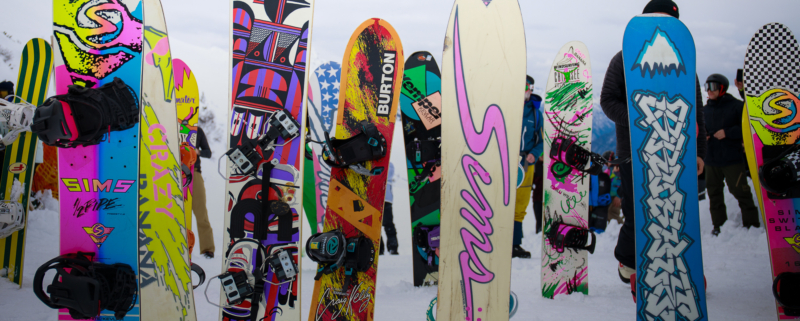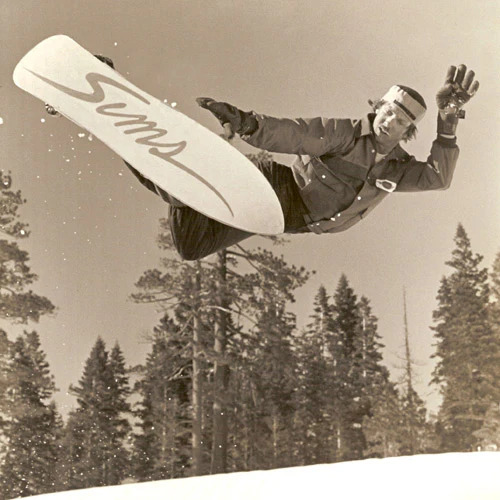
Snowboarding started to take flight in the late 70s and early 80s, and part of the reason for the meteoric rise of snowboarding was the creativity and rebellious attitude of pioneers of the sport. The early eye-catching boards (and mono-skis) allowed riders to show off their wild and funky side while doing something new and innovative. 50-odd years ago, when snowboards and mono-ski were battling it out for dominance, no one could have predicted just how big the snowboard market would get, while mono-skis disappeared almost entirely.
Snowboarding will always make those who look back today feel nostalgic. Change is good for the most part, but many early adopter brands were phased out of the game when newer competition started to arrive. SnowBrains readers helped to compile the emotional list of those legacy brands that may have gone out of business but never left the community’s hearts.
- Related Article: Top 9 Tips for Buying and Selling Gear at the Ski Swap
Top 5 Most Missed Snowboard Brands
#5 Checker Pig

#4 Kemper

Kemper Snowboards was founded in 1987 by David Kemper in Ontario, Canada, and quickly became one of the most iconic snowboard brands of the late 80s and early 90s. Known for their bold, neon graphics and designs that reflected the rebellious, counterculture spirit of the time, Kemper boards became especially popular among funky freestyle riders.
The brand’s snowboards were built for aggressive riding. They excel in freestyle and halfpipe competitions, making Kemper a standout in the growing snowboarding scene.
One of the brand’s most famous models was the Kemper Freestyle, which gained a strong following for its versatility and performance in the park. This board was known for its ability to easily handle jumps, tricks, and challenging terrain, appealing to riders who wanted high performance and eye-catching style. Kemper’s designs often mirrored the bold, colorful aesthetic of the late 80s and early 90s, setting the trend for snowboard culture during that period.
By the late 90s, the brand ceased operations, unable to keep pace with the rapid growth of its rivals. But, in 2018, Kemper Snowboards was revived, bringing back its retro-inspired designs and a new line of snowboards that embraced the brand’s roots. This revival reignited interest in Kemper’s history and its influence on snowboarding’s golden era. In 2019, they moved their headquarters to Park City, Utah, but were forced out of business again in 2022 and started selling NFTs.
#3 Morrow

Morrow Snowboards, founded in 1989 by Rob Morrow in Salem, Oregon, quickly stood out for its technical innovations and bold and distinct aesthetic. Morrow boards were known for their striking, almost futuristic visuals, which combined geometric patterns, abstract shapes, and vibrant color schemes. This unique aesthetic helped the brand appeal to a younger, freeriding generation that saw snowboarding as more than just a sport—it was a lifestyle.
The Morrow Blaze, one of the brand’s most famous models, performed well in the park and stood out for its sleek design. It incorporated clean lines and dynamic visuals that captured the energy of freestyle riding. Morrow eventually faced challenges as the snowboarding market became increasingly dominated by bigger brands like Burton and K2. In the late 90s, K2 Sports acquired Morrow, and although the brand continued under K2 for a while, it gradually faded from the spotlight.
#2 Barfoot Snoboards

In 1978, Chuck Barfoot decided to branch off from Sims and create something new with his own stamp of creativity. Barfoot Snoboards is credited with pioneering the full fiberglass board and debuting the swallow-like tail fin resembling a surfboard in the snow.
Barfoot Snoboards was known for its handcrafted quality and innovative designs that drew heavily from the fluid motion of surfing. The boards featured rounded tails and surf-inspired shapes, giving them a more natural, flowing feel than some of their competitors’ sharper, angular designs. The Barfoot Twin Tip, introduced in the late 1980s, became one of the brand’s most iconic boards. It was one of the first snowboards designed specifically for freestyle riding, with a symmetrical shape that allowed riders to land tricks in either direction. This board was highly influential in shaping the progression of freestyle snowboarding and was embraced by park and pipe riders for its versatility and performance.
Regarding aesthetics, Barfoot embraced a surf and skate-inspired graphic style, featuring colorful, hand-drawn art that gave the boards a distinct, laid-back vibe. The boards often had bold, cartoonish graphics with vibrant colors, reflecting the creative and rebellious energy of the early snowboarding scene. This aesthetic helped the brand appeal to riders who saw snowboarding as an extension of the surf and skate lifestyle.
Despite its early success and strong cultural influence, Barfoot Snowboards faced challenges as larger companies like Burton and Sims grew in dominance. Although Barfoot never became a massive brand, it maintained a strong following due to its focus on handcrafted quality and its roots in surf culture. Chuck Barfoot eventually stepped away from snowboarding as larger corporate players took over the market. Still, the brand remains a cult favorite for those who appreciate its influence on the sport’s early days.
#1 Sims

Sims Snowboards, founded by legendary snowboarder Tom Sims in 1976, is one of the pioneering brands in snowboarding history. Tom Sims transitioned from skateboarding and surfing to snowboarding, aiming to create a board that could mimic the fluid motion of surfing on snow. This vision led to the development of some of the first snowboards, initially crafted by modifying existing equipment.
Sims quickly gained a reputation for innovation and quality. One of the brand’s standout products was the Sims 158, released in the 80s. This board became highly regarded for its performance in freestyle riding. It featured a sintered base and a unique sidecut, providing excellent control and maneuverability for executing tricks and navigating various terrains.
The aesthetic of Sims Snowboards was characterized by bold graphic designs that reflected the vibrant, edgy culture of the 80s and early 90s. The boards showcased colorful, eye-catching graphics that resonated with the youth culture of the time, merging the styles of surfing and skateboarding with snowboarding’s emerging identity. This distinctive visual style helped Sims capture the attention of riders looking for performance and a strong expression of personal style on the slopes.
Sims faced challenges as the snowboarding market grew increasingly competitive in the 90s. The brand underwent several ownership changes, affecting its visibility in the industry. These transitions often led to shifts in product focus, marketing strategies, and design philosophies, diluting the brand’s original identity that Tom Sims had crafted.
In recent years, Sims has been “revitalized,” trying to return to its roots while appealing to a new generation of snowboarders. However, it has faced the challenge of operating in a vastly different market than it did during its heyday. The snowboarding landscape has become more commercialized, and larger companies dominate the industry, making it difficult for smaller or legacy brands to maintain their unique appeal.
Today, while Sims Snowboards is celebrated for its historical significance and ongoing commitment to innovation, the brand is not the same as it was in its early days. It now competes in a crowded market, focusing on modern technologies and trends that can differ significantly from the original ethos. Nonetheless, its legacy of pioneering spirit, bold aesthetics, and contributions to snowboarding continue to resonate with enthusiasts who appreciate the brand’s rich history.
